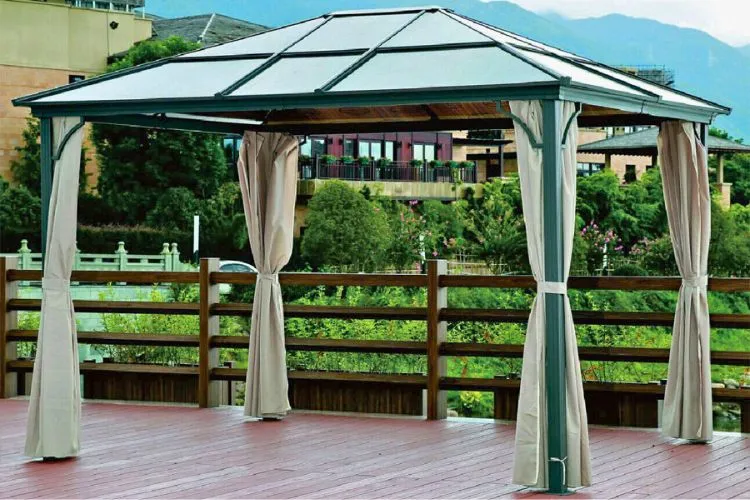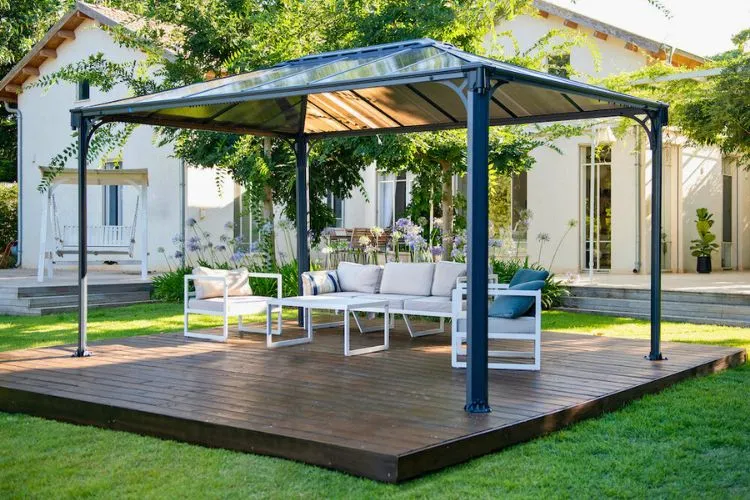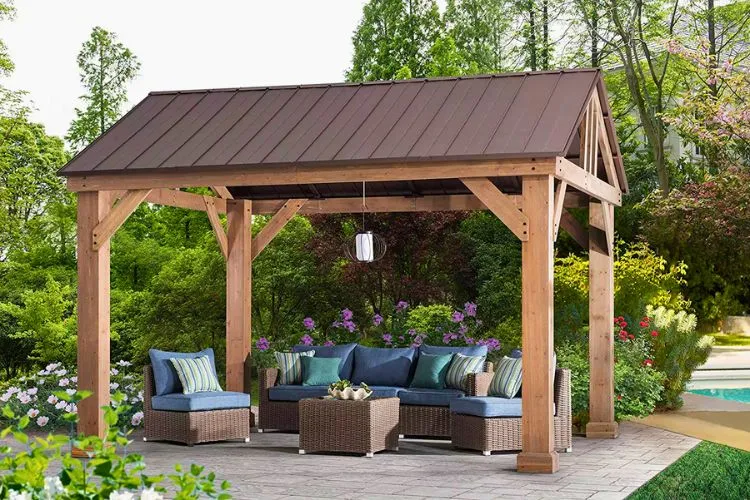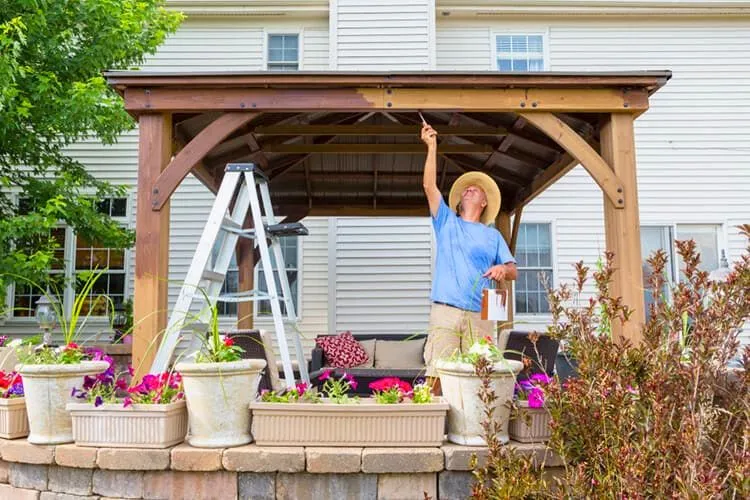Gazebos have long been celebrated as the crown jewels of outdoor spaces, offering both aesthetic appeal and functional shelter. However, when the skies turn gray and raindrops start to fall, many gazebo owners are left wondering: “Are gazebos waterproof?”
Understanding the waterproof nature of gazebos is essential for anyone looking to extend their living space outdoors, regardless of the season.

Contents
Are Gazebos Waterproof?
Yes, gazebos typically are waterproof to a degree. They are designed to provide shelter and should therefore be able to withstand different weather conditions, including rain. Most are constructed with water-resistant materials such as polyester or polyvinyl chloride (PVC).
However, while the materials are designed to repel water, they may not be 100% waterproof and can only resist water to some extent. This means that in heavy or constant rain, some water may still penetrate.
A gazebo’s waterproof capacity also depends on factors like its construction quality, maintenance, and age. Therefore, if you’re planning to use a gazebo in a region with heavy rainfall, ensure it’s suitable for such conditions by checking its waterproof rating or consult with the manufacturer.
Understanding Waterproofing in Gazebos
Waterproofing in gazebos is not just a matter of black and white; there’s a spectrum that ranges from water-resistant to fully waterproof. Knowing the difference is the first step to picking the right gazebo for your garden or patio.

Waterproof gazebos are designed to repel water, preventing it from penetrating the material, whereas water-resistant structures can handle a light drizzle but might succumb to a heavy downpour.
The importance of waterproofing cannot be overstated. It not only ensures that your gatherings can continue despite unpredictable weather, but it also protects the structure and integrity of the gazebo itself.
Water damage can lead to mold, rot, and even structural failure, thereby reducing the lifespan of this potentially significant investment.
Materials and Durability
Gazebos come in a variety of materials, each with its own set of advantages and water resistance levels. Fabric, wood, metal, and synthetic materials are among the most common. Fabric canopies, while offering flexibility and aesthetic variety, often require additional treatment to enhance their water resistance.
Wood, with its timeless appeal, needs to be treated or it will rot when exposed to too much water. Metal, particularly aluminum, presents a robust option with natural resilience against rust, especially when powder-coated.
Choosing materials that offer natural water resistance will aid in durability. Synthetic polymers and treated woods can stand up to the elements, ensuring your gazebo remains a centerpiece for many seasons to come.
Weatherproof Treatments for Gazebos
When it comes to waterproofing, there are both DIY and professional solutions available. Applying sealants, waterproof membranes, or even integrating a vinyl canopy are popular routes. Maintenance plays a significant role in the longevity of these treatments, with reapplication recommended every few years to maintain effectiveness.

The method of waterproofing will vary depending on the gazebo’s material, design, and the climate it’s exposed to. Acknowledging these factors and scheduling regular maintenance checks can vastly extend your gazebo’s lifespan and performance in wet weather.
You may also find useful: Do Gazebos Protect You From The Sun?
Design Features in Waterproof Gazebos
A gazebo’s design intricately influences its ability to withstand rainy conditions. A sloped roof design is not just aesthetically pleasing but functional, as it prevents water from pooling and causing structural damage. Moreover, features like gutter systems can divert water away from the structure, ensuring both the gazebo and the space underneath remain dry.
Attention to seams and the quality of sealants used can make or break a gazebo’s waterproof rating. Ensuring these are well-constructed and maintained is critical in enhancing the structure’s water resistance.
How to Choose a Waterproof Gazebo?
Selecting a waterproof gazebo necessitates a balance between design preferences, budget, and functional requirements. Consideration should be given to the gazebo’s intended use, location, and the typical weather conditions it will need to withstand.
Researching reputable brands and reading through reviews can offer insights into real-world performance and longevity.

Enhancing Your Gazebo’s Waterproofing
For gazebo owners looking to enhance their structure’s waterproofing, starting with a thorough inspection is key. Identifying any weak points or potential leaks can guide your waterproofing efforts. From reapplying sealants to installing additional drainage, step-by-step enhancements can significantly improve waterproof performance.
Keep in mind accessibility and safety, ensuring that any modifications do not compromise the structure’s integrity or pose risks to its users.
Common Mistakes to Avoid
One of the largest pitfalls in selecting or maintaining a waterproof gazebo is neglecting the importance of weight and wind resistance. A gazebo that stands up to rain but collapses in the wind is hardly useful.
Equally, overlooking the warranty and customer reviews can lead to disappointment. These often provide an unfiltered glimpse into the product’s performance and the manufacturer’s customer service, which can be invaluable when problems arise.
Frequently Asked Questions (FAQs)
Is every gazebo rainproof out of the box?
No, not all gazebos are designed to be waterproof. Many require additional treatments or specific materials to be rainproof.
How often do waterproof treatments need to be reapplied?
It largely depends on the material and the type of treatment used. However, as a general rule, inspecting and potentially reapplying waterproofing solutions every two to three years is a good practice.
Can waterproof gazebos withstand heavy storms?
While many waterproof gazebos are designed to handle moderate to heavy rain, their ability to withstand heavy storms also depends on their structural integrity, wind resistance, and proper installation.
Conclusion:
In conclusion, while not all gazebos are waterproof by default, with the right materials, design considerations, and maintenance, they can become resilient outdoor shelters capable of weathering any storm.
Regardless of whether you’re purchasing a new gazebo or looking to enhance an existing one, understanding and applying the principles of waterproofing will ensure your gazebo remains a functional, inviting space for years to come.

Sergio Gomes, a passionate advocate for outdoor living and the male voice behind Shades Authority. With years of experience, Sergio is your trusted source for expert insights on gazebos, pavilions, cabanas, pergolas, and all things outdoor shade solutions. Join him on a journey to transform your outdoor spaces into stunning, functional retreats
